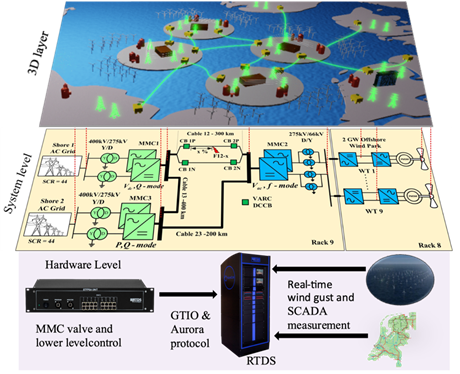Advanced Control for HVDC
Stable and Robust Advanced Control for Meshed Multi-Terminal High Voltage Direct Current Electrical Grids

Project Description
With the increasing integration of intermittent low-inertia offshore renewable energy and the growing demand for long-distance power transmission and interconnection, meshed offshore grids (MOGs) based on High Voltage Direct Current (HVDC) technology will become a key driver for future clean and intelligent European grids. This integration to a low inertia onshore electrical grid (due to decommissioning of synchronous machines) via MOG will create new stability issues in different time scales. Furthermore, interactions between the converter's control lead to instability problems. If early analysis of these scenarios is not considered, then it will rise to a brownout, or worse, to the cascaded blackout of the grid. Also, proper modeling of this hybrid ac-dc electrical grid must highlight the new components, phenomena, and advanced controls. The existing controls of the converter interfaced generations (CIGs), synchronous machines, and induction machines are based on conventional linear controllers. High penetration of CIGs together with the low inertia electrical grids will create a problem for grid synchronization due to high harmonic contents. In addition, most CIGs are non-linear; thus, the linear controller becomes absolute.
As a result following major questions need to be tackled:
- What are intelligent control principles needed to prevent unstable dynamic phenomena continuously?
- How to model a complex large-size multi-terminal HVDC electrical grid to simulate active and reactive power variations in the real-time simulation?
- How to identify the instability occurring in multi-terminal HVDC electrical grid?
- How to ensure the expandability and scalability of the intelligent control principles for the coordinated operation of a large-scale multi-terminal HVDC electrical grid?
This project focuses on developing stable, fast, and robust advanced control during a wide operation range. Furthermore, due to fast-response power electronic devices, the Electromagnetic Transient (EMT) simulation is appropriate for identifying the issues related to converter-driven stability. Thus, online EMT studies using a real-time simulator (RTS) are used for hardware-in-the-loop (HiL) testing of designed advanced control with detailed models of the converter and lower-level controls implemented on Field Programmable Gate Arrays (FPGAs).
Intended deliverables
- A stable and robust advanced controller design.
- DC fault current suppression control based on advanced design principles.
- Interoperability of traditional and advanced controllers.
- Digital twin of HVDC electrical grid and offshore wind power plant simulated in real-time.
TUD Team

Ajay Shetgaonkar
Ajay Shetgaonkar (Graduate Student Member, IEEE) was born on September 17th, 1993 in Goa, India. He received a B.E. degree in electrical and electronic engineering from Goa College of Engineering, Goa, India, in 2016. In 2020, he received an M.Sc. degree in electrical power engineering from the Delft University of Technology, the Netherlands (graduated “cum laude”, equivalent to maximum honors). He is currently working toward a Ph.D. degree at the Delft University of Technology, the Netherlands. His research interests include future power system dynamics and stability, integration of renewable energy resources, modeling of HVDC breakers, and design of advanced protection and control systems for modular multilevel converter-based HVDC systems in the HVDC electrical grid. He is also a student member of CIGRE.



